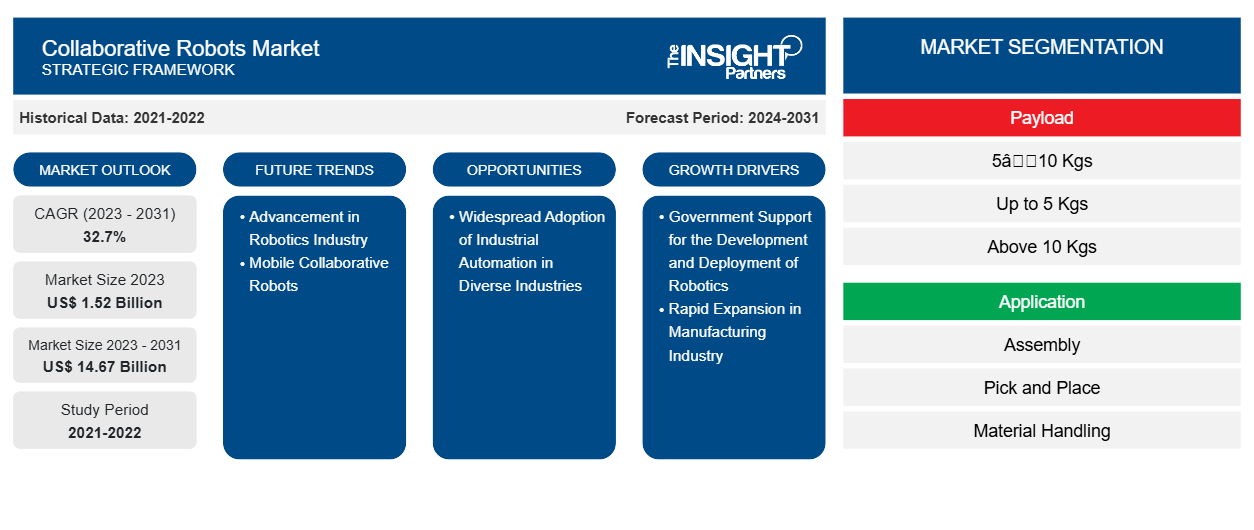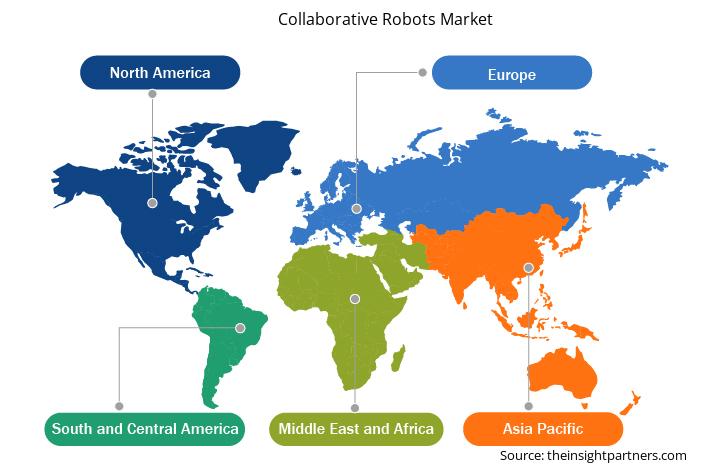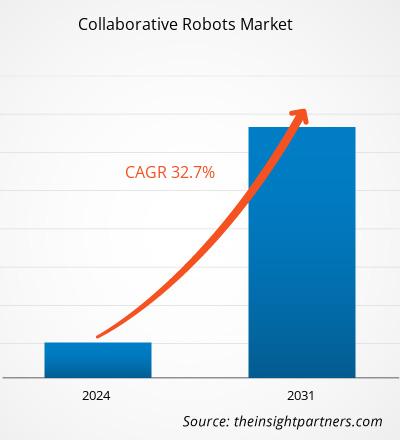Si prevede che il mercato dei robot collaborativi raggiungerà i 14,67 miliardi di dollari entro il 2031, rispetto agli 1,88 miliardi di dollari del 2024. Si prevede che il mercato registrerà un CAGR del 35,7% nel periodo 2025-2031. È probabile che i robot collaborativi mobili introducano nuove tendenze nel mercato.
Analisi di mercato dei robot collaborativi
I robot collaborativi sono un segmento di robot di servizio utilizzati nella movimentazione dei materiali, nella produzione e nei laboratori. La crescente domanda nelle fabbriche, in particolare nel settore manifatturiero, dove esseri umani e robot hanno già iniziato a lavorare in armonia, sta determinando la crescita del mercato dei robot collaborativi . L'avvento dei robot collaborativi ha creato un ambiente di lavoro affidabile in cui gli esseri umani possono lavorare in sicurezza a fianco dei robot. I fattori chiave che guidano il mercato includono il sostegno governativo allo sviluppo e all'implementazione della robotica e la rapida espansione dell'industria manifatturiera.
Panoramica del mercato dei robot collaborativi
Il panorama industriale sta attraversando una trasformazione significativa, trainata in gran parte dall'ascesa dei robot collaborativi: macchine avanzate progettate per lavorare in modo sicuro ed efficace a fianco degli esseri umani. Questi robot si stanno evolvendo in compagni di squadra intelligenti che migliorano la sicurezza, aumentano la produttività e supportano operazioni sostenibili. Operando a velocità equivalenti a quelle umane, i robot collaborativi semplificano la valutazione dei rischi legati al movimento, rendendo più facile per gli operatori nelle vicinanze evitare contatti involontari.
I governi di diverse nazioni in tutto il mondo stanno adottando iniziative per sostenere e promuovere lo sviluppo e l'adozione della robotica nei rispettivi paesi. Si prevede che tali iniziative e misure adottate dai governi stimoleranno la crescita del mercato della robotica industriale a livello globale, rafforzando così anche la domanda di robot collaborativi. Nel 2022, l'Europa ha detenuto la maggiore quota di fatturato del mercato globale dei robot collaborativi. In Europa, si prevede che il robusto settore automobilistico e la presenza di importanti case automobilistiche premium guideranno il mercato dei robot collaborativi. Inoltre, si prevede che la crescita della produzione di veicoli elettrici stimolerà la crescita del mercato dei robot collaborativi.
Riceverai la personalizzazione gratuita di qualsiasi report, incluse parti di questo report, analisi a livello nazionale, pacchetto dati Excel e potrai usufruire di fantastiche offerte e sconti per start-up e università.
Mercato dei robot collaborativi: approfondimenti strategici

- Scopri le principali tendenze di mercato di questo rapporto.Questo campione GRATUITO includerà analisi di dati che spaziano dalle tendenze di mercato alle stime e alle previsioni.
Driver e opportunità del mercato dei robot collaborativi
Sostegno governativo allo sviluppo e all'implementazione della robotica
I governi di diverse nazioni in tutto il mondo stanno adottando iniziative per sostenere e promuovere lo sviluppo e l'adozione della robotica nei rispettivi paesi. Ad esempio, il governo di Singapore, nell'ambito del suo Programma di Trasformazione Industriale, ha annunciato diverse misure per facilitare l'innovazione, l'automazione e l'espansione delle aziende, nonché per ottenere finanziamenti. Il governo indiano ha adottato diverse misure per promuovere la produzione intelligente in India, tra cui il programma Production Linked Incentive (PLI). Come importante iniziativa governativa per promuovere la produzione in India, il programma PLI è stato lanciato nel 2020 e ha interessato 14 settori, tra cui l'automotive, il farmaceutico, il tessile, l'industria alimentare e gli elettrodomestici. Inoltre, il governo cinese ha adottato diverse misure per l'implementazione della robotica industriale nel settore manifatturiero del paese. Tra queste, il piano "Made in China 2025" per lo sviluppo delle industrie high-tech. Il governo ha inoltre annunciato un "Piano quinquennale per lo sviluppo dell'industria robotica" per l'espansione del settore della robotica industriale cinese. Il governo sta offrendo notevoli sussidi e agevolazioni fiscali per l'automazione industriale. Inoltre, l'iniziativa tedesca Industria 4.0 include lo sviluppo e l'implementazione di robot industriali. Il governo ha annunciato l'erogazione di sovvenzioni in denaro a fondo perduto per circa 78 milioni di dollari all'anno per sostenere istituti di ricerca, aziende e istituti accademici nel periodo 2016-2020 per la ricerca sull'interazione uomo-tecnologia. Attualmente, il governo ha attivato circa 300 programmi di studio relativi all'automazione e alla robotica.
Il governo sudcoreano ha annunciato un piano di investimenti da 2,7 milioni di dollari, denominato "Secondo Piano Base per lo Sviluppo dei Robot Intelligenti, 2014-2018". Dopo la conclusione del Secondo Piano Base (2014-2018), il governo ha formulato e attuato il terzo Piano Base per lo Sviluppo dei Robot Intelligenti (2019-2023).
Rapida espansione nell'industria manifatturiera
Il panorama industriale si è evoluto enormemente negli ultimi tempi, con i robot collaborativi che svolgono un ruolo di primo piano nel guidare cambiamenti significativi. A differenza dei robot tradizionali, i cobot sono progettati per lavorare a fianco degli esseri umani e la loro programmazione prevede in genere misure di sicurezza che richiedono la collaborazione umana, limitandone l'operatività indipendente. Ciononostante, i cobot offrono notevoli incrementi di produttività, migliorando al contempo la sicurezza sul posto di lavoro e consentendo operazioni più flessibili ed economiche. Sono diventati componenti essenziali nelle industrie moderne, espandendo la loro presenza oltre il settore manifatturiero per includere strutture logistiche e sanitarie in tutto il mondo.
Nel settore manifatturiero, i cobot sono ampiamente utilizzati per attività di assemblaggio, saldatura, manutenzione macchine e confezionamento o pallettizzazione. La loro capacità di eseguire operazioni ripetitive e precise migliora la qualità del prodotto e riduce l'affaticamento dei dipendenti. Automatizzando le attività di routine, i cobot consentono ai lavoratori umani di concentrarsi su attività a più alto valore aggiunto, migliorando in definitiva la produttività, l'efficienza e la sicurezza sul lavoro in tutte le attività produttive. L'industria manifatturiera globale è in rapida espansione, con nuove regioni che investono in impianti di produzione. Questa espansione incoraggia l'innovazione tecnologica per migliorare la produttività degli impianti, mantenere un vantaggio competitivo con i clienti e acquisire un vantaggio competitivo. Pertanto, la rapida espansione dell'industria manifatturiera stimola la domanda di robot collaborativi a livello globale.
Analisi della segmentazione del rapporto di mercato sui robot collaborativi
I segmenti chiave che hanno contribuito alla derivazione dell'analisi di mercato dei robot collaborativi sono carico utile, applicazione, tipologia, settore dell'utente finale e funzionalità.
- In base al carico utile, il mercato è suddiviso in 5-10 kg, fino a 5 kg e oltre 10 kg. Il segmento 5-10 kg deteneva la quota di mercato maggiore nel 2024.
- In base all'applicazione, il mercato è suddiviso in assemblaggio, pick and place, movimentazione materiali, test di qualità, asservimento macchine, saldatura, imballaggio e altri. Il segmento dell'assemblaggio ha detenuto la quota di mercato maggiore nel 2024.
- Per tipologia, il mercato è suddiviso in bracci robotici, pistole per saldatura, pinze e altri. Il segmento dei bracci robotici deteneva la quota di mercato maggiore nel 2024.
- In base al settore di utilizzo finale, il mercato è segmentato in automotive, elettronica, metallurgia e macchinari, alimentare e delle bevande, logistica, farmaceutica e altri. Il segmento automotive ha dominato il mercato nel 2024.
- In base alla funzionalità, il mercato si divide in robot statici e robot mobili. Il segmento dei robot statici ha dominato il mercato nel 2024.
Analisi della quota di mercato dei robot collaborativi per area geografica
L'ambito geografico del rapporto di mercato sui robot collaborativi è suddiviso principalmente in cinque regioni: Nord America, Asia Pacifico, Europa, Medio Oriente e Africa e Sud e Centro America.
Nel 2024, l'Asia-Pacifico deteneva una quota significativa del mercato dei robot collaborativi. L'area Asia-Pacifico comprende molti paesi in via di sviluppo che stanno assistendo a una crescita significativa del loro settore manifatturiero. La regione è diventata un polo manifatturiero globale con la presenza di diversi settori manifatturieri. Mentre la Cina si è trasformata in un polo per la produzione altamente qualificata, economie emergenti come India, Corea del Sud, Taiwan e Vietnam stanno attraendo sempre più aziende che desiderano delocalizzare attività manifatturiere a bassa o media qualificazione. Questi paesi offrono costi del lavoro competitivi e promuovono attivamente gli investimenti diretti esteri attraverso iniziative governative di supporto. Tuttavia, per consolidare la loro posizione di principali destinazioni manifatturiere nella regione, queste nazioni devono affrontare sfide come la carenza di manodopera qualificata, i bassi livelli di produttività e le infrastrutture sottosviluppate.
I governi delle economie in via di sviluppo dell'area Asia-Pacifico stanno offrendo sgravi fiscali, finanziamenti, sussidi e altri tipi di supporto per attrarre le aziende manifatturiere a insediare i propri stabilimenti nei rispettivi paesi. Inoltre, diversi governi hanno avviato iniziative come Made in China 2025 e Make in India. Tuttavia, la Cina, il principale polo manifatturiero, sta registrando un aumento del costo del lavoro a causa dell'invecchiamento della popolazione. Ciò ha spinto le aziende manifatturiere a cercare investimenti nei paesi del Sud-est asiatico. Il miglioramento delle infrastrutture, l'aumento dei consumi interni e la riduzione dei costi sono alcuni dei fattori che attraggono le aziende manifatturiere in questi paesi.
La Cina è il maggiore produttore di autovetture al mondo. Giappone, India e Corea del Sud sono alcuni degli altri principali paesi produttori di veicoli nella regione Asia-Pacifico. Oltre all'industria automobilistica, diversi altri settori in Cina stanno implementando robot collaborativi; ad esempio, presso la Xiamen Runner Industrial Corporation, uno dei maggiori produttori di accessori per il bagno in Cina, 64 robot di Universal Robots sono stati impiegati sulla linea di produzione per svolgere diverse attività, che vanno dall'asservimento e dallo stampaggio a iniezione alle macchine per l'assemblaggio dei prodotti.
Approfondimenti regionali sul mercato dei robot collaborativi
Le tendenze e i fattori regionali che influenzano il mercato dei robot collaborativi durante il periodo di previsione sono stati ampiamente spiegati dagli analisti di Insight Partners. Questa sezione illustra anche i segmenti e la distribuzione geografica del mercato dei robot collaborativi in Nord America, Europa, Asia-Pacifico, Medio Oriente e Africa, e America meridionale e centrale.

- Ottieni i dati specifici regionali per il mercato dei robot collaborativi
Ambito del rapporto di mercato sui robot collaborativi
| Attributo del report | Dettagli |
|---|---|
| Dimensioni del mercato nel 2025 | 1,88 miliardi di dollari USA |
| Dimensioni del mercato entro il 2031 | 14,67 miliardi di dollari USA |
| CAGR globale (2025-2031) | 35,7% |
| Dati storici | 2021-2023 |
| Periodo di previsione | 2025-2031 |
| Segmenti coperti | Per carico utile
|
| Regioni e paesi coperti | America del Nord
|
| Leader di mercato e profili aziendali chiave |
|
Densità degli attori del mercato dei robot collaborativi: comprendere il suo impatto sulle dinamiche aziendali
Il mercato dei robot collaborativi è in rapida crescita, trainato dalla crescente domanda degli utenti finali, dovuta a fattori quali l'evoluzione delle preferenze dei consumatori, i progressi tecnologici e una maggiore consapevolezza dei vantaggi del prodotto. Con l'aumento della domanda, le aziende stanno ampliando la propria offerta, innovando per soddisfare le esigenze dei consumatori e sfruttando le tendenze emergenti, alimentando ulteriormente la crescita del mercato.
La densità degli operatori di mercato si riferisce alla distribuzione delle imprese che operano in un determinato mercato o settore. Indica quanti concorrenti (operatori di mercato) sono presenti in un determinato spazio di mercato in relazione alle sue dimensioni o al suo valore totale.
Le principali aziende che operano nel mercato dei robot collaborativi sono:
- Kuka AG
- Yaskawa America Inc
- Aubo (Pechino) Robotics Technology Co Ltd
- Doosan Robotics Inc
- Fanuc Corp
- ABB Ltd
Disclaimer : le aziende elencate sopra non sono classificate secondo alcun ordine particolare.

- Ottieni una panoramica dei principali attori del mercato dei robot collaborativi
Notizie e sviluppi recenti sul mercato dei robot collaborativi
Il mercato dei robot collaborativi viene valutato raccogliendo dati qualitativi e quantitativi a seguito di ricerche primarie e secondarie, che includono importanti pubblicazioni aziendali, dati di associazioni e database. Di seguito sono elencati alcuni degli sviluppi nel mercato dei robot collaborativi:
- OMRON ha annunciato la disponibilità dei robot collaborativi OMRON™ Serie S, progettati per diverse applicazioni in diversi settori. Questi cobot introducono hardware avanzato, maggiori funzionalità e certificazioni di sicurezza e funzionalità di configurazione di nuova generazione, rendendoli più facili da usare che mai. (Fonte: OMRON, comunicato stampa, settembre 2024)
- TÜV Rheinland Group, ente indipendente di certificazione, ispezione e collaudo di terze parti leader a livello internazionale, ha rilasciato a ESTUN Automation Co., Ltd. il Certificato di Conformità alla Direttiva Macchine CE e alla Sicurezza Funzionale per i prodotti ESS (ESTUN Safety Solution). Questo attesta i rapidi progressi compiuti da ESTUN nella realizzazione di un sistema completo di sicurezza funzionale per robot. Questa certificazione non solo dimostra la forza innovativa e il livello professionale di ESTUN nel campo della tecnologia robotica, ma riflette anche il suo rigoroso controllo e impegno per la sicurezza e la qualità dei prodotti, e migliorerà ulteriormente la qualità e l'efficienza del servizio di ESTUN sul mercato globale. (Fonte: ESTUN Robotics, Comunicato Stampa, aprile 2024)
Copertura e risultati del rapporto sul mercato dei robot collaborativi
Il rapporto "Dimensioni e previsioni del mercato dei robot collaborativi (2021-2031)" fornisce un'analisi dettagliata del mercato che copre le seguenti aree:
- Dimensioni e previsioni del mercato dei robot collaborativi a livello globale, regionale e nazionale per tutti i principali segmenti di mercato coperti dall'ambito
- Tendenze del mercato dei robot collaborativi, nonché dinamiche di mercato come driver, vincoli e opportunità chiave
- Analisi PEST e SWOT dettagliate
- Analisi di mercato dei robot collaborativi che copre le principali tendenze del mercato, il quadro globale e regionale, i principali attori, le normative e i recenti sviluppi del mercato
- Analisi del panorama industriale e della concorrenza che copre la concentrazione del mercato, l'analisi della mappa di calore, i principali attori e gli sviluppi recenti per il mercato dei robot collaborativi
- Profili aziendali dettagliati
- Analisi storica (2 anni), anno base, previsione (7 anni) con CAGR
- Analisi PEST e SWOT
- Valore/volume delle dimensioni del mercato - Globale, Regionale, Nazionale
- Industria e panorama competitivo
- Set di dati Excel
Report recenti
Testimonianze
Motivo dell'acquisto
- Processo decisionale informato
- Comprensione delle dinamiche di mercato
- Analisi competitiva
- Analisi dei clienti
- Previsioni di mercato
- Mitigazione del rischio
- Pianificazione strategica
- Giustificazione degli investimenti
- Identificazione dei mercati emergenti
- Miglioramento delle strategie di marketing
- Aumento dell'efficienza operativa
- Allineamento alle tendenze normative




















 Ottieni un campione gratuito per - Mercato dei robot collaborativi
Ottieni un campione gratuito per - Mercato dei robot collaborativi